
This blog is devoted to exploring the history, historic sites and heritage tourism opportunities of the American South! A guide to new additions and updates to the expansive site www.exploresouthernhistory.com, this blog features forts, battlefields, Native American sites, architectural treasures and natural wonders.
Friday, December 19, 2008
Battle of Massard Prairie now available thorugh Amazon

Sunday, December 14, 2008
Old Courthouse Museum - Vicksburg, Mississippi

Friday, December 5, 2008
U.S.S. Cairo - A Civil War Ironclad on Display

Thursday, December 4, 2008
Battle of Vicksburg, Mississippi

Sunday, November 30, 2008
Battle of Prairie Grove Events set for Next Weekend

Thursday, November 27, 2008
Special Three Day Holiday Sale on Books by Dale Cox
 If you are interested in purchasing copies of any of my books as holiday gifts this year, you might consider checking out a special online sale that will take place for the next three days only.
If you are interested in purchasing copies of any of my books as holiday gifts this year, you might consider checking out a special online sale that will take place for the next three days only.Prices on all available titles will be reduced for these three days only. The sale will end on Sunday, November 30th, at midnight.
Because of a change in publishers that I will be announcing soon, this will be the only sale on any of the books this year.
The sale is now over, but check here for current pricing on my various books.
Here is a list of the current titles available:
- The Battle of Natural Bridge, Florida
- The Battle of Marianna, Florida
- The Battle of Massard Prairie, Arkansas
- Two Egg, Florida
- The History of Jackson County, Florida: Volume One
- The Early History of Gadsden County
Tuesday, November 25, 2008
Graves of U.S. Soldiers that Florida may close to the public

Monday, November 24, 2008
Florida State Parks and Historic Sites Facing Closure - Please Speak UP!

The State of Florida is considering closing a number of its state parks and historic sites due to budget constraints.
Included among these are:
- San Marcos de Apalache Historical State Park in St. Marks - The site of Spanish fortifications dating back to the 17th century, San Marcos was occupied by British troops during the American Revolution and was among the Spanish posts captured by Andrew Jackson during his 1818 invasion of Florida. It was here that the Ambrister, Arbuthnot and Prophet Francis executions took place, sparking an international incident. The park was also the site of Fort Ward, an unconquered Confederate fort that played a critical role in the Battle of Natural Bridge, Florida.
- Constitution Convention Museum State Park in Port St. Joe - This museum preserves the site where Florida's first constitution was drafted and also protects artifacts related to the famed "lost city" of St. Joseph.
- John Gorrie Museum State Park in Apalachicola - This museum preserves artifacts in information on the life of Dr. John Gorrie, the 19th century Apalachicola physician acclaimed as the inventor of the ice machine and, as a by product, of air conditioning.
While I certainly understand the need of Florida's government to live within its budgets, surely there must be better ways of coming up with needed dollars than closing (permanently or temporarily) the state's noteworthy historic sites. Not only does this violate a trust established between the state's government and its people, it jeapordizes the history of this beautiful and great state.
Please join me in writing to Gov. Charlie Crist at Charlie.Crist@MyFlorida.com to voice your opposition to the closure of these and other Florida State Parks and historic sites and to encourage the governor to look in other areas were much greater cost savings can surely be realized.
Thank you!
Thursday, November 20, 2008
Breaking News: Florida Saves Natural Bridge Battlefield!

AND FLORIDA SPRING
~Florida Forever acquisition preserves 54.74 acres adjacent to Natural Bridge
Historic State Park~
TALLAHASSEE— Governor Crist and Cabinet today approved the purchase of 54.74 acres of land adjacent to the Natural Bridge Historic State Park in Leon County. The acquired parcel is significant to the protection of a first magnitude spring and features a Civil War battlefield.
“This important purchase is a part of the Florida First Magnitude Springs project and one of the top projects on the Florida Forever priority list,” said Florida Department of Environmental Protection (DEP) Deputy Secretary Bob Ballard. “This acquisition ensures that the geological, historical and cultural integrity of this property and the surrounding water resources are preserved for Floridians and visitors from all over the world to enjoy for years to come.”
This Florida Forever project focuses on land that provides increased protection for Florida’s First Magnitude Springs that discharge more than 100 cubic feet of water per second. Florida’s springs, scattered through northern and central Florida, draw from the Floridan aquifer system, which is the state’s primary source of drinking water. Springs, with clear, continuously flowing waters, are among the state’s most important natural resources and are famous attractions. This acquisition brings the Florida First Magnitude Springs project closer to completion, with 7,844 acres of the 14,081 acre project remaining.
The property contains many karst features such as sink holes, natural bridges, swallets, karst windows and submerged cave systems. By preserving the surrounding land, this project will preserve the area’s geological significance and protect Florida’s water resources from the effects of commercial, residential and agricultural runoff and other potential impacts.
The property is also the site of Florida’s second largest Civil War battle. It is listed on the National Register of Historic Places and cited as one of the top ten endangered Civil War sites in the United States by the Civil War Preservation Trust. In 1865, during the final week of the Civil War, the battle at natural bridge preserved Tallahassee as the only Confederate Capitol east of the Mississippi that did not surrender to Union forces. Today, important historical and cultural, resources can be found on the property dating from the Paleo-Indian period (10,000 B.C.) to the Civil War. The property will eventually be managed by DEP’s Division of Recreation and Parks as part of the Natural Bridge Historic State Park.
Originally established in 1999, the 10-year, $3 billion Florida Forever program is the largest land-buying initiative in the nation, conserving environmentally sensitive land, restoring water resources and preserving important cultural and historical sites. More than two million acres throughout the state have been placed in public ownership under Florida Forever and its predecessor program, Preservation 2000 (P2000). For more information on the Florida Forever program, visit http://www.dep.state.fl.us/lands/acquisition/FloridaForever/.
To view maps that outline the subject parcel in this purchase, visit the following links: www.dep.state.fl.us/secretary/news/2008/11/files/rakestraw_springs76.pdf
www.dep.state.fl.us/secretary/news/2008/11/files/rakestraw_springs77.pdf
--30--
Friday, November 14, 2008
Fort Gaines, Georgia - History on the Chattahoochee

Monday, November 10, 2008
Providence Canyon State Park - Lumpkin, Georgia

Sunday, November 9, 2008
An Artifact of the Second Seminole War

Saturday, November 8, 2008
Honey Springs Battlefield State Park - Oklahoma

Thursday, November 6, 2008
New Blog: History of Gadsden County, Florida

Petit Jean State Park - Arkansas
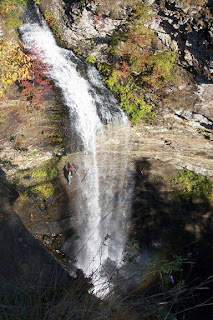
Wednesday, November 5, 2008
Talladega National Forest - Alabama
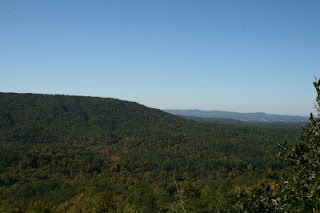
Doug Ghee Accessible Trail at Cheaha State Park, Alabama
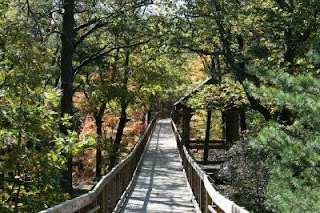
Tuesday, November 4, 2008
Waterfalls of the Cheaha State Park Area - Alabama

Monday, November 3, 2008
Remember to Vote!
No matter your candidates of choice, please take time to exercise your right as an American citizen and vote!
We often get so lost in the television ads and rigors of the campaigns that we forget just how precious this right is to us. According to the best statistics available, an estimated 1,341,756 American soldiers have given their lives in the of duty in wars and military conflicts since the days of the American Revolution. By voting, we honor each and every one of them even though many of their names have been long forgotten.
Cheaha State Park and Mt. Cheaha, Alabama

Sunday, November 2, 2008
Cheaha State Park, Alabama - New Pages Online!

Friday, October 31, 2008
Two-Toed Tom - The Alligator Monster of Florida and Alabama

A Murderer's Ghost in Macon, Georgia
An example is the 1885 report of a haunted house in Macon, Georgia.
According to widespread reports that year, a house in the community was haunted by the ghost of a man that had killed his wife before taking his own life. Neighbors reported seeing and hearing unusual things in the house and one former friend of the man even went to investigate.
To read the story of the "Murderer's Ghost of Macon, Georgia," please visit: www.exploresouthernhistory.com/maconghost.
The Shooting Star Ghost of Georgetown, South Carolina
This spectre appeared repeatedly during the decades following the Civil War and was covered by newspapers around the South.
The ghost was believed to have been that of a slave that killed his "master" during the closing years of the war. He paid for this act with his life and, for years after, reappeared and disappeared rapidly in the area. These quick appearances gave him the name of the "shooting star ghost."
If you would like to read an early newspaper account of the "Shooting Star" ghost, please visit www.exploresouthernhistory.com/shootingstarghostsc. Please be aware that some of the language in the article does not fit with modern standards.
The Bell Witch appears in Alabama
The alleged Alabama sighting took place in Lauderdale County in 1912 and involved a strange dog-like animal similar to the one reported in the original Tennessee accounts of the Bell Witch haunting.
The incident was reported in Alabama newspapers that year and attracted considerable attention.
To read the original coverage of the Alabama "Bell Witch" sightings, please visit www.exploresouthernhistory.com/bellwitch2.
The Plowing Ghost of Fernandina, Florida
The ghost was first noticed by a farmer as he looked out the window of his home while sitting up with a sick child. To his surprise, the mysterious figure of a man could be seen plowing a nearby field in the gloom of the night. Although the night was dark, the figures of the man and his horse were strangely illuminated.
The man sent his son out to investigate, only to watch in shock as the boy walked directly through the strange apparition without seeing it.
The story soon became well known throughout the area and was covered by newspapers throughout the country.
If you would like to read more about Fernandina's Plowing Ghost, please visit www.exploresouthernhistory.com/plowingghostofflorida.
Watch for Ghost Stories throughout the day on Halloween!
Saturday, October 25, 2008
Southern Ghosts Part Twelve - The Bell Witch, Tennessee

Friday, October 24, 2008
Southern Ghosts Part Eleven - Petit Jean's Ghost, Arkansas

Tuesday, October 21, 2008
Southern Ghosts Part Ten - The Edgefield Ghost, South Carolina
The following is the initial report from the Edgefield Courier newspaper of July 11, 1829:
A public curiosity has been greatly excited, and many tales more or less true, have gone out, concerning the mysterious and invisible being, that has been heard at Mr. Isaac Burnett's, in this District, for some time, it seems proper that the Public should be in possession of the facts relative to this extraordinary circumstance. The voice was first heard in October last, imitating various noises, such as that of th espinning wheel, reel ducks, hens, & c. It was first heard by Mr. Burnett, about twenty yards from the house, which led him to suppose it was some of the neighbor's children, hiding in the weeds and trying to frighten his children. It was afterwards heard in the loft of the house and Mr. B. supposing it to be a bird, sent a boy up to drive it out, but nothing could be seen. It thus continued to perplex the minds of the family for some time, until, at length, one of the children said he believed that thing could talk, and commenced asking questions, which it answered by whistling, pretty much like a Parrot. This circumstance getting out, many persons came to hear it. Mr. John Shepherd, a...worthy citizen, who lives in the neighborhood, conversed with it in presence of a nuber of witnesses. To ascertain the extent of its knowledge, he asked it various questions about most persons in the neighborhood and their circumstances which it answered correctly. It told his name and the number of children he had; also, the names of most of the persons present. He asked what it came there for. It replied, "Because it had no other place to go." It was asked if it came to do the family harm, it said no - it loved the family. It was asked finally if it loved Jesus Christ, to which it made no reply, nor answered any more question, which Mr. Shepherd asked. The evening after, it answered others, but would not answer him. For the first three months it was heard only once a month....
The Edgefield ghost continued to draw considerable attention in newspapers through 1829 and 1830, but coverage of the strange spirit finally diminished. Accounts indicate, however, that numerous people heard and conversed with it in 1829 and that it was sometimes heard whistling "Yankee Doodle."
Monday, October 20, 2008
Southern Ghosts Part Nine - Fayetteville, Arkansas

Saturday, October 18, 2008
Southern Ghosts Part Eight - Bellamy Bridge, Florida

Friday, October 17, 2008
Southern Ghosts Part Seven - St. Simons Lighthouse, Georgia

Thursday, October 16, 2008
Southern Ghosts Part Six - Poison Spring, Arkansas

Wednesday, October 15, 2008
Southern Ghosts Part Five - Warden Castle in St. Augustine, Florida
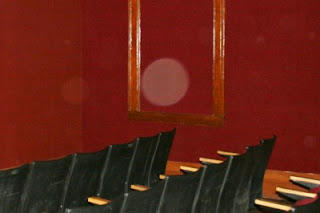
Tuesday, October 14, 2008
Southern Ghosts Part Four - Rich Mountain, Arkansas

Monday, October 13, 2008
Southern Ghosts Part Three - Big Cedar, Missouri

Sunday, October 12, 2008
Southern Ghosts Part Two - The Crescent Hotel, Arkansas
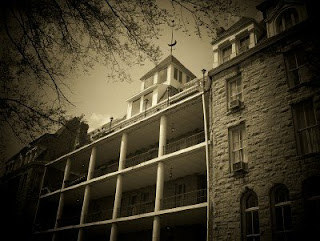
Saturday, October 11, 2008
Southern Ghosts Part One - St. Augustine Lighthouse, Florida

Sunday, September 28, 2008
Ghosts of the South! - Coming in October

Saturday, September 20, 2008
Battle of Marianna, Florida Tours set for next Saturday...

Friday, September 19, 2008
Submarine Smuggling not a new concept...

Tuesday, September 16, 2008
Special Series on the 1864 Raid on Marianna, Florida

Sunday, September 14, 2008
Poison Spring Series at Civil War Arkansas

Thursday, September 11, 2008
New Book is now Available in Hardcover and Paperback

If you pre-ordered a copy, your book should arrive no later than the end of next week. If you are expecting a copy and it hasn't arrived by then, please let me know so I can check on it for you.
Saturday, September 6, 2008
Battle of Poison Spring pages now online!

Monday, September 1, 2008
Hurricane Gustav moving through Louisiana
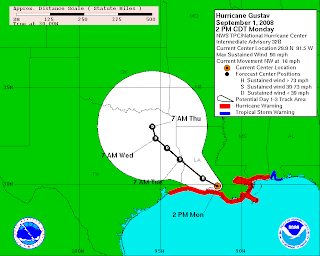
Sunday, August 31, 2008
Hurricane expected to Strike on Monday

Saturday, August 30, 2008
Hurricane Gustav threatening Gulf Coast

Saturday, August 23, 2008
Tropical Storm Fay Update
If you are planning to travel South this weekend, please stay up to date on the latest weather conditions. Not only are flights being impacted, but there is widespread flooding across Florida and tornado activity has been reported throughout the storm area. Some areas in the vicinity of Tallahassee have reported 22 inches of rain so far.
The Jackson County Times newspaper in Marianna, Florida provides good updates for that area and links to video updates and an array of other information on the storm, so please visit them if you would like to keep up with things. Just click here to visit their site.
Thursday, August 21, 2008
Update: Florida State Park Closings due to Tropical Storm Fay
You can view current video updates on the storm at www.jacksoncountytimes.net.
TALLAHASSEE – The Florida Department of Environmental Protection (DEP) today announced the closure and re-opening of several state recreation areas, preserves and district offices on Thursday, August 21. Closed facilities will remain closed until further notice due to imminent weather conditions.
Regulatory District Office Closed (1)
DEP Northeast District Office
7825 Baymeadows Way, Suite B200
Jacksonville, Florida 32256
Regulatory District Office Re-opening (1)
DEP Southeast District Branch Office
1801 SE Hilmoor Drive, Suite C-204
Port St. Lucie, Florida 34952
State Parks Re-opening (8)
Anastasia State Park – Day Use Open; Campground is Closed
1340-A State Road A1A South
St. Augustine, Florida 32080
Fort Pierce Inlet State Park
905 Shorewinds Drive
Ft. Pierce, Florida 34949
Faver-Dykes State Park – Day Use Open; Campground is Closed
1000 Faver-Dykes Road
St. Augustine, Florida 32086
Fort Clinch State Park – Day Use Open; Campground is Closed
2601 Atlantic Avenue
Fernandina Beach, Florida 32034
Talbot Island State Park – Day Use Open; Campground is Closed
12157 Heckscher Drive
Jacksonville, Florida 32226
Collier-Seminole State Park
20200 E. Tamiami Trail
Naples, Florida 34114
Highlands Hammock State Park
5931 Hammock Road
Sebring, Florida 33872
Long Key State Park – Day Use Open; Campground is Closed
67400 Overseas Highway
Long Key, Florida 33001
State Park Closures (5)
(Includes 2 New Closures *)
Gamble Rogers State Park
3100 S. State Road A1A
Flagler Beach, Florida 32136
Kissimmee Prairie
33104 N.W. 192nd Avenue
Okeechobee, Florida 34972
Tomoka State Park
2099 North Beach Street
Ormond Beach, Florida 32174
*Bulow Creek State Park
3351 Old Dixie Highway
Ormond Beach, Florida 32174
*Bulow Plantation Ruins Historic State Park
County Road 2001
Flagler Beach, Florida
Coastal and Aquatic Managed Areas (CAMA) Re-opening (1)
Southeast Aquatic Preserves Office
3300 Lewis Street
Ft. Pierce, Florida 34981
Coastal and Aquatic Managed Areas (CAMA) Closures (3)
(Includes 1 New Closure *)
*Guana Tolomato Matanzas National Estuarine Research Reserve
and Environmental Learning Center
505 Guana River Road
Ponte Vedra Beach, Florida 32082
East Central Florida Aquatic Preserves
3783 North Indian River Drive
Cocoa, Florida 32926
Northeast Aquatic Preserves Office
13802 Pumpkin Hill Road
Jacksonville, Florida 32226
Office of Greenways and Trails (OGT) Closures (5)
(Includes 2 Re-Closures *)
Cross Florida Greenway
Buckman Lock Visitor Center
200 Buckman Lock Road
Palatka, Florida 32177
Cross Florida Greenway
Rodman Campground
410 Rodman Road
Palatka, Florida 32177
Cross Florida Greenway
Santos Campground
3080 SE 80th Street
Ocala, Florida 34491
*Cross Florida Greenway
Sharpes Ferry Office
8282 SE Hwy 314
Ocala, Florida 34470
*Van Fleet State Trail Office
7500 Bay Lake Road
Groveland, Florida 34736
For additional information, visit www.dep.state.fl.us or www.floridadisaster.org.
Florida State Parks Update
--
TALLAHASSEE – The Florida Department of Environmental Protection (DEP) today announced the closure and re-opening of several state recreation areas, preserves and district offices on Wednesday, August 20. Closed facilities will remain closed until further notice due to imminent weather conditions.
Regulatory District Offices Closed (2):
DEP Northeast District Office
7825 Baymeadows Way, Suite B200
Jacksonville, Florida 32256
DEP Southeast District Branch Office
1801 SE Hilmoor Dr., Suite C-204
Port St. Lucie, Florida 34952
State Parks Re-opening (35):
Alafia River State Park
14326 South County Road 39
Lithia, Florida 33547
Cayo Costa State Park
Located directly south of Boca Grande
Boca Grande, Florida 33921
Charlotte Harbor Preserve State Park
12301 Burnt Store Road
Punta Gorda, Florida 33955
Collier-Seminole State Park – Day Use Only
20200 E. Tamiami Trail
Naples, Florida 34114
Delnor Wiggins State Park
11135 Gulf Shores Drive
Naples, Florida 34108
Don Pedro Island State Park
Boating location is Nautical Waterproof Chart #25
Intercoastal Waterway sign guides visitors to the park
Boca Grande, Florida 33821
Estero Bay Preserve State Park
Located near Estero between Ft. Myers and Naples
Estero, Florida 33928
Fakahatchee Strand State Park
137 Coastline Drive
Copeland, Florida
Gasparilla Island State Park
880 Belcher Road
Boca Grande, Florida 33821
Hillsborough River State Park
15402 US 301 N
Thonotosassa, Florida 33592
Hugh Taylor Birch State Park
3109 E. Sunrise Blvd
Ft. Lauderdale, Florida 33304
Koreshan State Park
U.S. 41 at Corkscrew Road
Estero, Florida 33928
Lake Manatee State Park
20007 SR 64
Bradenton, Florida 34202
Little Manatee River State Park
215 Lightfoot Road
Wimauma, Florida 33598
Lovers Key State Park
8700 Estero Blvd.
Ft. Myers Beach, Florida 33931
Mound Key State Park
Located several miles by boat from Lovers Key State Park or Koreshan State Park
Estero, Florida 33928
Myakka River State Park
13208 State Road 72
Sarasota, Florida 34241
Oscar Scherer State Park
1843 S. Tamiami Trail
Osprey, Florida 34229
Paynes Creek State Park
888 Lake Branch Road
Bowling Green, Florida 33834
Skyway Fishing Pier State Park
4905 34th Street South, #5000
St. Petersburg, Florida 33711
Stump Pass Beach State Park
Located at the end of Manasota Key off I-75, exit 191
Englewood, Florida
Atlantic Ridge State Park
16450 SE Federal Highway
Hobe Sound, Florida 33455
Avalon State Park
905 Shorewinds Drive
Ft. Pierce, Florida 34949
Bill Baggs Cape Florida State Park
1200 S. Crandon Blvd.
Key Biscayne, Florida 33149
Dagny Johnson Key Largo Hammock Botanical State Park
County Road 905
Key Largo, Florida 33037
Indian Key Historic State Park
U.S. 1 Mile Marker 85.5
Islamorada, Florida 33036
John D. MacArthur Beach State Park
10900 State Road 703 A1A
North Palm Beach, Florida 33408
John U. Lloyd Beach State Park
6503 N. Ocean Drive
Dania Beach, Florida 33004
Jonathan Dickinson State Park – River Campground Closed
16450 SE Federal Hwy.
Hobe Sound, Florida 33455
Lignumvitae Key Botanical State Park
U.S. 1 Mile Marker 85.5
Islamorada, Florida 33036
Oleta River State Park
3400 NE 163rd Street
N. Miami, Florida 33160
Seabranch Preserve State Park
State Road A1A near the VFW parking lot
Stuart, Florida 34997
St. Lucie Inlet Preserve State Park
4810 SE Cove Rd.
Stuart, Florida 34997
The Barnacle Historic State Park
3485 Main Hwy.
Coconut, Grove, Florida 33133
Windley Key Fossil Reef Geological State Park
U.S. 1 Mile Marker 85.5
Islamorada, Florida 33036
State Parks Closed (9):
Fort Clinch State Park – Day Use Open; Campground is Closed
2601 Atlantic Avenue
Fernandina Beach, FL 32034
Talbot Island State Park – Day Use Open; Campground is Closed
12157 Heckscher Drive
Jacksonville, Florida 32226
Kissimmee Prairie State Park
33104 NW 192nd Avenue
Okeechobee, Florida 34972
Gamble Rogers State Park
3100 S. State Road A1A
Flagler Beach, Florida 32136
Tomoka State Park – Day Use Open; Campground is Closed
2099 North Beach Street
Ormond Beach, FL 32174
Faver-Dykes State Park – Day Use Open; Campground is Closed
1000 Faver-Dykes Road
St. Augustine, FL 32086
Anastasia State Park – Day Use Open; Campground is Closed
1340-A State Road A1A South
St. Augustine, FL 32080
Highlands Hammock State Park
5931 Hammock Road
Sebring, FL 33872
Fort Pierce Inlet State Park
905 Shorewinds Drive
Fort Pierce, FL 34949
Coastal and Aquatic Managed Areas Closed (3):
East Central Florida Aquatic Preserves
3783 North Indian River Drive
Cocoa, FL 32926
Northeast Aquatic Preserves Office
13802 Pumpkin Hill Road
Jacksonville, FL 32226
Southeast Aquatic Preserves Office
3300 Lewis Street
Ft. Pierce, FL 34981
Greenways and Trails Re-opening (5):
Cross Florida Greenway
Sharpes Ferry Office
8282 SE Hwy 314
Ocala, Florida 34470
Cross Florida Greenway
Inglis Lock Office
20751 SE 90th Avenue
Inglis, Florida 34449
Withlacoochee State Trail Office
315 N Apopka
Inverness, Florida 34450
Nature Coast State Trail Office
22 SE 2nd Avenue
Chiefland, Florida 32693
Van Fleet State Trail Office
7500 Bay Lake Road
Groveland, Florida 34736
Greenways and Trails Closed (3):
Cross Florida Greenway
Buckman Lock Visitor Center
200 Buckman Lock Road
Palatka, Florida 32177
Cross Florida Greenway
Rodman Campground
410 Rodman Road
Palatka, Florida 32177
Cross Florida Greenway
Santos Campground
3080 SE 80th Street
Ocala, Florida 34491
For more information, visit www.dep.state.fl.us or www.floridadisaster.org.
Monday, August 18, 2008
Dozens of State Parks close in Florida due to Tropical Storm
Many of the areas are important historic sites, so please take note if you plan to be traveling in the Sunshine State over the next few days:
TALLAHASSEE – The Florida Department of Environmental Protection (DEP) today announced the closure of several state parks, preserves and district offices as of 5 p.m. until further notice due to imminent weather conditions.
Closed parks, preserves and offices include:
Regulatory District Offices (4):
South District Fort Myers Office
2295 Victoria Avenue
Ft. Myers, Florida 33901
South District Marathon Branch Office
2796 Overseas Highway, Suite 221
Marathon, Florida 33050
South District Sebring Satellite Office
2812 Kenilworth Blvd.
Sebring Florida 33870
Southwest District Office
13051 North Telecom Parkway
Temple Terrace, FL 33637-0926
State Parks Closed (41):
Bahia Honda State Park
36850 Overseas Hwy.
Big Pine Key, Florida 33043
Curry Hammock State Park
56200 Overseas Hwy.
Marathon, Florida 33050
Dagny Johnson Key Largo Hammock Botanical State Park
County Road 905
Key Largo, Florida 33037
Fort Zachary Taylor Historic State Park
300 Truman Annex
Key West, Florida 33041
Indian Key Historic State Park
U.S. 1 Mile Marker 85.5
Islamorada, Florida 33036
John Pennekamp Coral Reef State Park
U.S. 1 Mile Marker 102.5
Key Largo, Florida 33037
Lignumvitae Key Botanical State Park
U.S. 1 Mile Marker 85.5
Islamorada, Florida 33036
Long Key State Park
U.S. 1 Mile Marker 67.5
Long Key, Florida, 33001
San Pedro Underwater Archeological State Park
U.S. 1 Mile Marker 85.5
Islamorada, Florida 33036
Windly Key Fossil Reef Geological State Park
U.S. 1 Mile Marker 85.5
Islamorada, Florida 33036
Honeymoon Island State Park
#1 Causeway Blvd
Dunedin, Florida 34698
Caladesi Island State Park
#1 Causeway Blvd
Dunedin, Florida 34698
Anclote Key State Park
#1 Causeway Blvd
Dunedin, Florida 34698
Egmont Key State Park
4905 34th Street S., #5000
Dunedin, Florida 34698
Cayo Costa State Park
880 Belcher Road
Boca Grande, Florida 33921
Oscar Scherer State Park
1843 S. Tamiami Trail
Osprey, Florida 34229
Fakahatchee State Park
137 Coastline Drive
Copeland, Florida
Delnor Wiggins State Park
11135 Gulf Shores Drive
Naples, Florida 34108
Lovers Key State Park
8700 Estero Blvd.
Ft. Myers Beach, Florida 33931
Koreshan State Park
3800 Corkscrew Road
Estero, Florida 33928
Mound Key State Park
3800 Corkscrew Road
Estero, Florida 33928
Little Manatee Rive State Park
215 Lightfoot Road
Wimauma, Florida 33598
Myakka River State Park
13208 State Road 72.
Sarasota, Florida 34241
Skyway Fishing Pier State Park
#1 Causeway Blvd.
Dunedin, Florida 34698
Terra Ceia Preserve State Park
3708 Patton Ave.
Ellenton, Florida 34222
Madira Bickel Mound State Park
3708 Patton Ave.
Ellenton, Florida 34222
Judah P. Benjamin State Park
3708 Patton Ave.
Ellenton, Florida 34222
Lake Manatee State Park
20007 SR 64
Bradenton, Florida 34202
Beker State Park
3708 Patton Ave.
Ellenton, Florida 34222
Stump Pass Beach State Park
880 Belcher Road
Boca Grande, Florida 33821
Don Pedro Island State Park
880 Belcher Road
Boca Grande, Florida 33821
Gasparilla Island State Park
880 Belcher Road
Boca Grande, Florida 33821
Collier-Seminole State Park
20200 E. Tamiami Trail
Naples, Florida 34114
Estero Bay Preserve State Park
3800 Corkscrew Road
Estero, Florida 33928
Hugh Taylor Birch State Park
3109 E. Sunrise Blvd
Ft. Lauderdale, Florida 33304
John U. Lloyd Beach State Park
6503 N. Ocean Drive
Dania Beach, Florida 33004
Oleta River State Park
3400 NE 163rd Street
N. Miami, Florida 33160
The Barnacle Historic State Park
3485 Main Hwy.
Coconut, Grove, Florida 33133
Bill Baggs Cape Florida State Park
1200 S. Crandon Blvd.
Key Biscayne, Florida 33149
St. Lucie Inlet Preserve State Park
4810 SE Cove Rd.
Stuart, Florida 34997
Jonathan Dickinson State Park- Campground Closed
16450 SE Federal Hwy.
Hobe Sound, Florida 33455
Coastal and Aquatic Managed Areas (6):
Biscayne Bay Aquatic Preserve and Coral Reef Conservation Program:
1277 NE 79th Street Causeway
Miami, Florida 33138
Charlotte Harbor Aquatic Preserves Office
12301 Burnt Store Road
Punta Gorda, Florida 33955
Estero Bay Aquatic Preserve
700-1 Fishermans Wharf
Ft. Myers Beach, Florida 33931
Florida Keys National Marine Sanctuary
33 East Quay Road
Key West, FL 33040
and
95230 Overseas Hwy.
Key Largo, Florida 33037
Rookery Bay National Estuarine Research Reserve
300 Tower Road
Naples, Florida 34113
Terra Ceia Aquatic Preserve Office
130 Terra Ceia Road
Terra Ceia, Florida 34250
For more information on state park closures, visit www.floridastateparks.org. For additional information, visit www.dep.state.fl.us or www.floridadisaster.org.